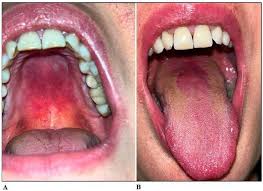Oral candidiasis, commonly referred to as oral thrush, is a fungal infection in the oral cavity caused predominantly by Candida albicans. It manifests as white, creamy patches on the tongue, inner cheeks, palate, and throat. While often benign, the infection can become persistent or invasive in immunocompromised individuals or those with underlying health conditions. Timely diagnosis and targeted treatment are essential to prevent complications and recurrence.

Understanding Candida: The Yeast Behind the Infection
Candida albicans is a commensal fungus present in the oral, gastrointestinal, and genital tracts. Under normal immune function and microbial balance, its growth is kept in check. However, when local or systemic immunity is compromised or the oral microbiota is disrupted, Candida can proliferate, leading to infection.
Types of Oral Candidiasis
Understanding the subtypes is crucial for accurate diagnosis and effective treatment.
1. Pseudomembranous Candidiasis
- Most common form (classic “thrush”)
- White, curd-like plaques that can be wiped off, leaving red mucosa underneath
2. Erythematous (Atrophic) Candidiasis
- Red, painful patches on the palate or tongue
- Common in denture wearers and after antibiotic use
3. Hyperplastic (Chronic) Candidiasis
- Persistent white plaques that cannot be wiped off
- Often linked to smoking or immunosuppression
4. Angular Cheilitis
- Cracking, redness, and soreness at the corners of the mouth
- May co-occur with other forms of oral candidiasis
Causes and Risk Factors for Oral Candidiasis
The development of oral candidiasis is multifactorial. Several local and systemic factors may trigger fungal overgrowth.
Local Risk Factors
- Poor oral hygiene
- Dentures, especially if ill-fitting or worn overnight
- Dry mouth (xerostomia)
- Smoking
- Topical corticosteroids (inhalers without proper rinsing)
Systemic Risk Factors
- Antibiotic therapy, which disrupts the balance of oral flora
- Immunosuppression due to HIV/AIDS, cancer treatment, or organ transplantation
- Diabetes mellitus
- Nutritional deficiencies, particularly iron and vitamin B12
- Endocrine disorders such as hypothyroidism
Signs and Symptoms of Oral Candidiasis
The clinical presentation may vary depending on the type and severity of the infection.
- White or yellowish plaques on the tongue, inner cheeks, or throat
- Redness and soreness of the oral mucosa
- Burning sensation or discomfort when eating
- Altered taste (dysgeusia)
- Dry mouth
- Cracked lips or angular cheilitis
- Pain while swallowing in advanced cases
Diagnosing Oral Candidiasis
Accurate diagnosis ensures appropriate management and prevents unnecessary treatments.
Clinical Evaluation
- Visual inspection of characteristic lesions
- History of recent antibiotic use, immunosuppression, or denture use
Laboratory Testing
- Microscopic examination of oral swabs stained with KOH or Gram stain to identify fungal elements
- Fungal cultures for persistent or recurrent infections
- Biopsy in chronic cases to rule out dysplasia or malignancy
- Blood glucose testing to assess for undiagnosed diabetes
Differential Diagnosis
Conditions mimicking oral candidiasis include:
- Leukoplakia – white patches that cannot be scraped off
- Lichen planus – presents with lace-like white striations
- Aphthous ulcers
- Oral hairy leukoplakia – typically seen in HIV-positive patients
- Burn injuries from hot foods
Treatment of Oral Candidiasis
Topical Antifungal Therapy
- Nystatin suspension (100,000 units/mL) – swish and swallow 4 times daily
- Clotrimazole troches (10 mg) – dissolve in mouth 5 times daily
- Miconazole oral gel – applied directly to affected areas
Systemic Antifungal Agents
- Fluconazole 100–200 mg/day – typically for 7–14 days
- Itraconazole or posaconazole – in fluconazole-resistant cases
Adjunctive Measures
- Improve oral hygiene and denture care
- Rinse mouth after using corticosteroid inhalers
- Discontinue smoking
- Address underlying systemic conditions
- Use of antiseptic mouthwashes in resistant cases
Oral Candidiasis in Special Populations
In Infants
- Common due to immature immune systems
- Presents with fussiness, feeding refusal
- Treated with nystatin suspension
In HIV/AIDS Patients
- Higher risk of recurrence and resistance
- May require systemic antifungals for prophylaxis
In the Elderly
- Often linked to denture use, dry mouth, or medications
- Emphasis on hygiene and saliva substitutes
Prevention and Oral Health Maintenance
Effective preventive strategies reduce recurrence and improve overall oral health:
- Brush and floss daily
- Disinfect dentures nightly and avoid overnight use
- Avoid excessive sugar and refined carbohydrates
- Limit broad-spectrum antibiotic use
- Manage chronic diseases such as diabetes
Complications of Untreated Oral Candidiasis
If left unmanaged, oral candidiasis can lead to:
Esophageal candidiasis – presenting with dysphagia and odynophagia
- Systemic candidiasis in immunocompromised individuals
- Recurrent infections
- Impaired nutrition due to pain and reduced intake
Oral candidiasis remains a common and often preventable fungal infection. Though frequently benign, its persistence or recurrence warrants thorough evaluation for underlying systemic disorders. Proper diagnosis, effective antifungal therapy, and diligent oral hygiene practices are fundamental to successful treatment and prevention of complications. Patients at higher risk, including those with immunosuppressive conditions or chronic diseases, should be monitored closely for early signs of recurrence.